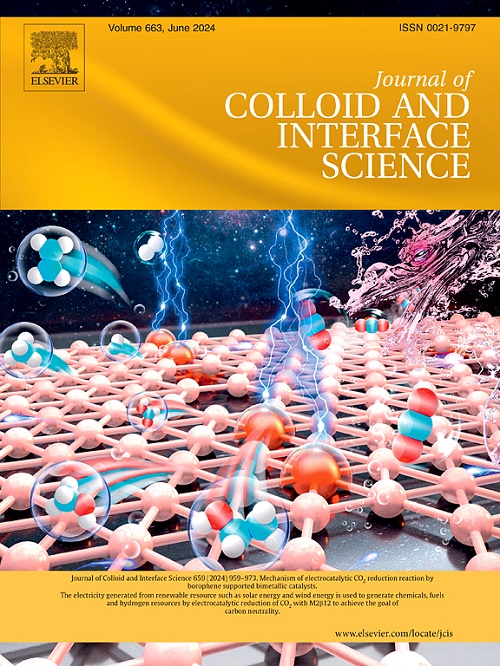S-scheme C3N5/Fe2TiO5异质结增强光催化析氢:偶极子场和内电场的协同贡献
IF 9.7
1区 化学
Q1 CHEMISTRY, PHYSICAL
引用次数: 0
摘要
太阳能驱动的光催化水分解为绿色H2的产生提供了一条可持续的途径,但在实际应用中仍存在一些挑战,包括光生载流子重组严重、光生电子和空穴对分离和转移效率低、光催化剂效率低下等。为了解决这些问题,我们成功地构建了基于C3N5 (CN)和Fe2TiO5 (FTO)纳米颗粒的S-scheme CN/FTO (C3N5/Fe2TiO5)异质结光催化剂体系。在模拟太阳辐照下,CN/FTO异质结的光催化制氢率显著提高,达到607.7 μmol g−1 h−1,分别是纯CN和FTO的9.5倍和7.1倍。光催化效率的提高是由于在CN/ fto界面形成的内电场(IEF)和富氮CN的固有结构和电子特性协同调制了光生电荷转移。这种合作显著加速了CN和FTO界面之间以及CN内部光生载流子的分离和定向转移。在实验表征的基础上,提出了S-scheme光生载流子转移机理。CN结构特征和CN异质结IEF的共同作用诱导了良好的能带弯曲,并通过S-scheme途径促进了有效的电荷分离和转移,从而增强了光催化活性。本研究强调了界面IEF和CN的固有结构和电子性质在协同调节光生载流子的定向迁移中的关键作用。它通过s方案异质结工程,特别是利用富氮碳氮化物,介绍了光生电荷迁移和光催化反应控制的动力学。本文章由计算机程序翻译,如有差异,请以英文原文为准。

S-scheme C3N5/Fe2TiO5 heterojunction for enhanced photocatalytic H2 evolution: Synergistic contribution of dipole field and internal electric field
Solar-driven photocatalytic water splitting provides a sustainable route for producing green H2, but there are still several challenges in its practical application, including severe recombination of photogenerated charge carriers, low separation and transfer efficiency of photogenerated electron and hole pairs, and inefficient photocatalysts. To address these issues, we successfully constructed an S-scheme CN/FTO (C3N5/Fe2TiO5) heterojunction photocatalyst system based on C3N5 (CN) and Fe2TiO5 (FTO) nanoparticles by simple hydrothermal assembly of two pre-fabricated semiconductors. Under simulated solar irradiation, the CN/FTO heterojunction exhibits significantly improved photocatalytic H2 production rate, reaching 607.7 μmol g−1 h−1, which is 9.5- and 7.1-fold higher than pure CN and FTO, respectively. The improvement in photocatalytic efficiency is attributed to synergistic modulation of photogenerated charge transfer by the internal electric field (IEF) formed at the CN/FTO interface and intrinsic structural and electronic features of the nitrogen-rich CN. This collaboration significantly accelerates the separation and directional transfer of photogenerated charge carriers between the CN and FTO interface and within the CN itself. Based on experimental characterizations, an S-scheme photogenerated charge carrier transfer mechanism is proposed. The combined effects of the CN/FTO heterojunction IEF and the CN structural features induce favorable band bending and facilitate efficient charge separation and transfer via the S-scheme pathway, thereby enhancing photocatalytic activity. This study emphasizes the crucial role of the interfacial IEF and the intrinsic structural and electronic properties of CN in synergistically regulating the directional migration of photogenerated charge carriers. It presents insights into the dynamics of photogenerated charge migration and photocatalytic reaction control through S-scheme heterojunction engineering, particularly utilizing nitrogen-rich carbon nitrides.
求助全文
通过发布文献求助,成功后即可免费获取论文全文。
去求助
来源期刊
CiteScore
16.10
自引率
7.10%
发文量
2568
审稿时长
2 months
期刊介绍:
The Journal of Colloid and Interface Science publishes original research findings on the fundamental principles of colloid and interface science, as well as innovative applications in various fields. The criteria for publication include impact, quality, novelty, and originality.
Emphasis:
The journal emphasizes fundamental scientific innovation within the following categories:
A.Colloidal Materials and Nanomaterials
B.Soft Colloidal and Self-Assembly Systems
C.Adsorption, Catalysis, and Electrochemistry
D.Interfacial Processes, Capillarity, and Wetting
E.Biomaterials and Nanomedicine
F.Energy Conversion and Storage, and Environmental Technologies

 求助内容:
求助内容: 应助结果提醒方式:
应助结果提醒方式:


